Your cart is currently empty!
Tag: Apply to Imperial College London
-
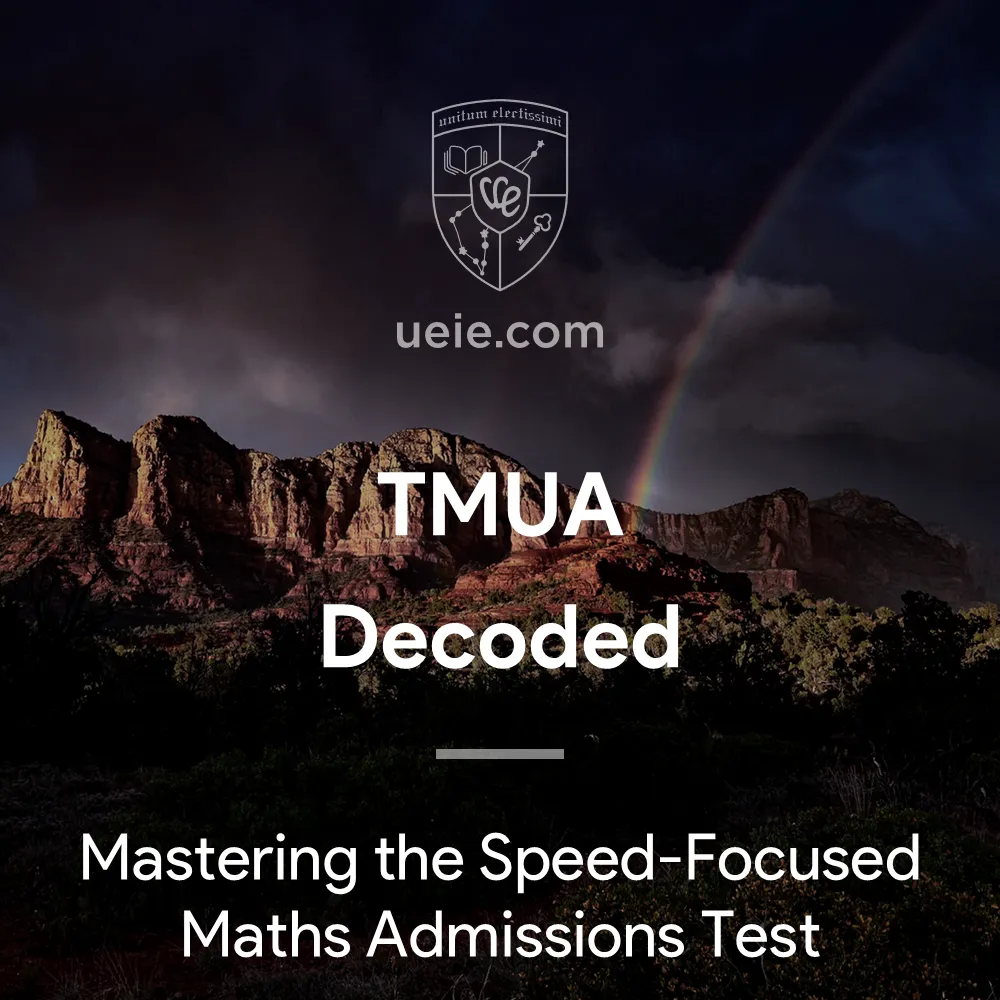
TMUA Decoded: Mastering the Speed-Focused Maths Admissions Test
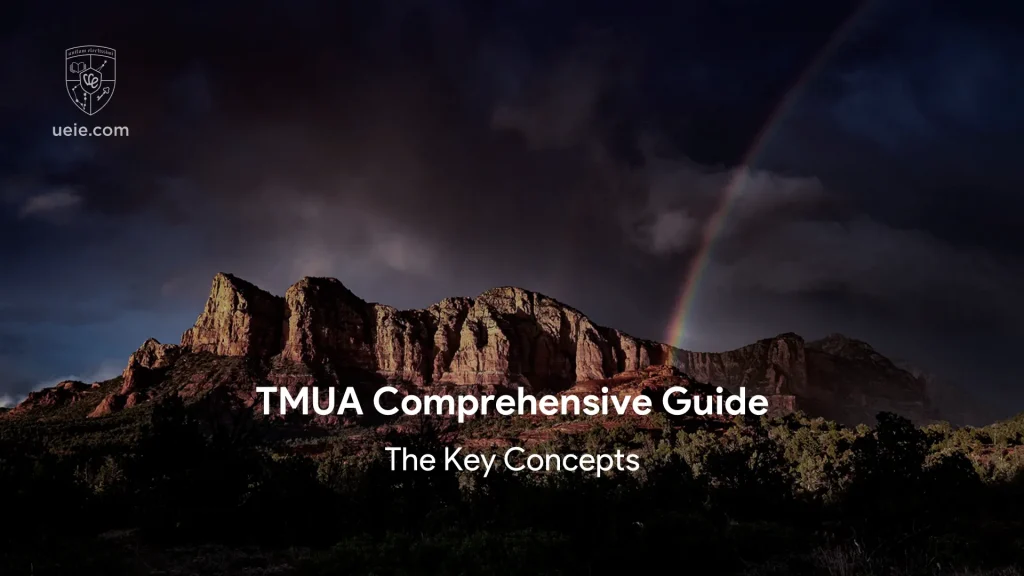
The Test of Mathematics for University Admission (TMUA) is increasingly utilised by leading UK universities as a key means of evaluating applicants’ mathematical aptitude and potential. To help you get fully up to speed with the latest requirements and test details for the 2026 entry application cycle, I’ve drawn on my years of experience coaching for Oxbridge admissions tests to write this TMUA Comprehensive Guide. This guide provides a systematic overview of the latest TMUA developments, university requirements, key dates, test format, scoring criteria, syllabus content, and essential preparation resources, offering you a comprehensive and authoritative reference.
Once you have a general understanding of the TMUA, we recommend reading follow-up UEIE articles: TMUA Registration Guide and TMUA Preparation Guide, for more detailed instructions on registration and preparation strategies.
I. What is the TMUA Mathematics Test?
TMUA stands for the Test of Mathematics for University Admission. Its primary purpose is to assess an applicant’s ability to apply mathematical knowledge to solve problems, as well as their potential for mathematical reasoning. Several top UK universities – including the University of Cambridge, Imperial College London, the London School of Economics and Political Science (LSE), and University College London (UCL) – use the TMUA to help select applicants for undergraduate courses in Mathematics, Computer Science, Economics, and related disciplines.
II. Latest Updates on the 2025 TMUA Test
The TMUA test has undergone significant adjustments in recent years. Keeping abreast of these latest developments is crucial for both preparation and registration.
1. Unified Management Body UAT-UK
Since 2024, TMUA has been managed centrally by UAT-UK, a non-profit organisation jointly established by the University of Cambridge and Imperial College London. It now forms part of their assessment framework alongside the Engineering and Science Admissions Test (ESAT) and the Thinking Assessment for Arts and Humanities (TARA, introduced in 2025).
2. Test Format and Delivery Partner
TMUA is administered as an online, computer-based test. It is delivered by the global assessment provider Pearson VUE through its worldwide network of certified test centres.
3. Specific Date Arrangements and Restrictions
Since 2024, TMUA typically offers testing windows in October and the following January.
- Testing Window Choice: Candidates applying for 2026 entry to relevant courses at the University of Cambridge must take the test in October 2025; the January 2026 session is not an option for them.
- Specific Date Restriction: Candidates applying to the University of Cambridge from Mainland China, Hong Kong, or Macau are not permitted to take the TMUA test on 13 October 2025. Consequently, applicants from these regions targeting relevant Cambridge courses can only sit the TMUA on 14 October 2025.
- Verification is Essential: Please be aware that the specific dates and times available for booking may differ between test centres. Always consult the Pearson VUE registration system and official UAT-UK announcements for the most accurate and up-to-date information.
4. Increasingly Specific University Requirements
As the UAT-UK assessment system has become established, TMUA’s significance as an admissions tool for certain leading universities and specific degree programmes (particularly in Mathematics, Computer Science, and Economics) has grown. Several programmes now mandate or strongly recommend the TMUA (further details are provided in the next section).
III. Who Needs to Take the TMUA Test? (For 2026 Entry)
Specific TMUA requirements vary between UK universities and degree programmes. These requirements can change annually and can be quite detailed (e.g., specifying whether the test is compulsory, recommended, or simply an alternative option). Therefore, all candidates are strongly advised to treat the official websites of their chosen universities as the ultimate authority for the latest admissions information specific to 2026 entry.
1. G5 University Courses Requiring TMUA Scores
The table below lists G5 university courses known to require TMUA scores, provided for reference.
University Courses Approximate Score Reference* Alternative Test / Notes University of Cambridge Computer Science (G400) 7.5+ Usually no alternative Economics (L100) 7.0+ Usually no alternative Imperial College London Mathematics Dept. Programmes (G100, G103, etc.) 6.5+ STEP might be considered in exceptional circumstances, e.g., post-deadline (check website for latest info) Economics, Finance and Data Science (L1N3) 6.5+ London School of Economics (LSE) Economics (L101) 7.0+ Econometrics and Mathematical Economics (L142) 7.0+ Mathematics and Economics (GL11) 7.0+ University College London (UCL) Economics (L100) 6.5+ UCL’s test requirements are complex; check website. Some economics-related programmes may move to TARA *Approximate Score Reference: This is based on unofficial data from previous admission cycles and does not represent a minimum required score.
2. TMUA Requirements at Other Universities
- University of Warwick: Requires applicants for Mathematics, Statistics, Computer Science, and Economics-related courses to submit TMUA scores. However, for Mathematics and Statistics courses, STEP or AEA scores may be accepted as alternatives.
- Durham University, University of Bath, and others: In the past, some Mathematics, Economics, and Computer Science related courses at these and other universities have also required TMUA scores.
Requirements regarding the TMUA test for specific courses at different universities can change. Once you have decided which universities and courses you are applying to, it is recommended that you consult the official university websites to understand the latest and most accurate entry requirements.
IV. TMUA Test Key Dates
Below is a summary of the key dates for the Autumn 2025 and Early 2026 testing sessions. Please note that the registration periods shown are provisional; you should closely monitor official announcements for confirmed dates.
1. Autumn 2025 (1st Sitting) Schedule
Key Stage Date Registration Period 31 Jul – 29 Sep 2025 Test Dates 13–14 October 2025 Results Release 14 Nov 2025* Key Restrictions:
- Candidates applying for Economics and Computer Science at the University of Cambridge must take the test during this session.
- Candidates applying to the University of Cambridge from Mainland China, Hong Kong, or Macau are not permitted to sit the test on 13 October 2025 and must therefore take it on 14 October 2025.
2. Early 2026 (2nd Sitting) Schedule
Key Stage Date Registration Period 27 Oct – 19 Dec 2025 Test Dates 8–9 January 2026 Results Release Approx. 6 weeks after test* Key Restrictions:
- This session is not available for candidates applying to the University of Cambridge.
*UAT-UK will notify candidates by email when their results are available to view in their UAT-UK account. Candidates will also receive a document explaining how to interpret their results.
V. TMUA Test Format and Structure
The table below summarises the key elements of the TMUA test format.
Item Details Format Online Computer-based Test, taken at a Pearson VUE test centre. Paper Structure Two Papers: - Paper 1: Applications of Mathematical Knowledge
- Paper 2: Mathematical Reasoning
Question Type Multiple Choice Questions Number of Questions 20 questions per paper, total 40 multiple-choice questions. Duration 75 minutes per paper, total 150 minutes. Timing Each paper is timed separately. Time unused in Paper 1 cannot be carried over to Paper 2. Calculator Calculators are not permitted. Formula Sheet Formula sheets are not permitted. VI. TMUA Scoring Mechanism and Result Interpretation
1. Scoring Mechanism and Score Conversion
- Raw Score: Each multiple-choice question is worth 1 mark. Incorrect answers or unanswered questions score 0 marks. The maximum raw score for each paper is 20, making the total maximum raw score for the test 40.
- Score Conversion: To ensure comparability of results across different test sittings, raw scores are converted to a standardised scale ranging from 1.0 to 9.0, usually reported to one decimal place. Universities primarily use this 9.0-scale standardised score for assessment purposes.
- Important Change in Results Report: From 2024 onwards, the official TMUA results report provided by UAT-UK only includes the overall converted score, no longer providing separate converted scores for Paper 1 and Paper 2. A more detailed official explanation of the results report can be downloaded from the UAT-UK website.
2. Result Interpretation: Competitiveness Analysis by Score Band
There is no official Pass Mark for TMUA. Whether a score is competitive depends entirely on the university and course you are applying to, as well as the overall standard of applicants in that year. Based on the official UAT-UK explanation of the 2024/25 TMUA results and my own experience with students, here is an interpretation of some representative scores:
- 4.5 is the average score: This suggests that most students achieve scores around 4.5. From observing numerous students, the majority who attain an A* in A-Level Mathematics can reach this level without systematic preparation. A score of 4.5 can be broadly considered equivalent to an A* standard in A-Level Maths.
- Around 7.0 places you in the top 10%: Based on application cases from students I coached last year, those achieving this score typically received interview invitations from Cambridge and had a high success rate in securing offers from other G5 universities like Imperial and LSE.
- Only about 5% of candidates score 8.0 or above: Candidates scoring in the 8.0-9.0 range are undoubtedly highly competitive. Although Cambridge’s final decision also considers interview performance and other application materials, such scores significantly increase the chances of receiving offers from top institutions like Imperial, LSE, and UCL.
VII. TMUA Syllabus and Difficulty Analysis
Understanding what TMUA assesses and where its difficulties lie is fundamental to devising an effective preparation plan.
1. Syllabus Overview for TMUA Test
Although the organising body for TMUA test changed in 2024, the overall syllabus has seen little change, especially for Paper 2, where the syllabus remained untouched.
Paper 1: Applications of Mathematical Knowledge
- Assessment Objective: To assess the candidate’s ability to apply mathematical knowledge flexibly to solve problems.
- Knowledge Scope: Primarily based on AS Level Mathematics content, including Algebra and Functions, Coordinate Geometry, Sequences and Series, Trigonometry, Exponentials and Logarithms, Calculus, and Graphing Functions. It also covers some GCSE Mathematics content, such as Number and Units, Ratio and Proportion, Basic Algebra, Geometry, Statistics, and Probability.
Paper 2: Mathematical Reasoning
- Assessment Objective: To assess the candidate’s ability in mathematical reasoning and logical thinking.
- Knowledge Scope: Builds upon the mathematical knowledge required for Paper 1.
- Emphasis: Focuses on understanding the logic of arguments, mathematical proof (including identifying common errors in proofs), and higher-level logical reasoning problems.
Accessing the Official Latest Syllabus
Please ensure you consult the latest version of the TMUA syllabus document published on the UAT-UK official website.
2. Difficulty Characteristics Analysis
The difficulty of TMUA differs from tests like STEP. It doesn’t lie in the intrinsic complexity or abstruseness of the problems, but rather in the following aspects:
- Extreme Time Pressure: The average time of 3.75 minutes per multiple-choice question is the core challenge of TMUA test. This demands not only solid knowledge but also exceptional problem-solving efficiency and speed.
- Breadth of Knowledge and Fluency: The test covers a wide range, requiring candidates to be extremely fluent with fundamental concepts, able to recall and apply them quickly and accurately. The prohibition of calculators places higher demands on mental arithmetic and written calculation skills.
- Mathematical Reasoning Requirements: The logical thinking, proof comprehension, and error identification skills tested in Paper 2 require dedicated training to adapt and improve accuracy.
- Multiple-Choice Format: Although multiple-choice, the questions and options are often cleverly designed, incorporating traps and distractors, necessitating careful reading, precise calculation, and effective elimination. There are no marks for working, yet the demand for accuracy is extremely high.
In short, TMUA primarily assesses a student’s fluent application of mathematical knowledge and the agility and accuracy of their mathematical reasoning under strict time constraints. Its difficulty stems more from the demands for ‘speed’ and ‘accuracy’ rather than ‘depth’ and ‘complexity’.
VIII. How to Register for the TMUA Test?
Since 2024, the registration process for the TMUA test has changed compared to the past, primarily conducted through the officially designated online platform.
1. Main Pathway
Candidates need to register via the website of Pearson VUE, the official partner testing service for UAT-UK. This usually involves first creating a UAT-UK personal account and then using that account to book a test session and location.
2. Key Reminders
- Registration Deadline: Pay close attention to the official registration deadline for the test session you plan to take (refer to Section IV of this article, and confirm with the final official announcement). Complete registration and payment in advance.
- Limited Test Slots: Test slots in popular locations may be limited. It is advisable to register and book your test as early as possible once registration opens.
3. Registration Process
Detailed information regarding the steps for account creation, required information, test centre search and selection, test fees, payment methods, and applications for special arrangements (if needed) are all explained step-by-step in our dedicated guide.
Please click the following post for the most complete and accurate operational instructions.

How to Register for TMUA
Unlock your TMUA potential with our comprehensive guide! Follow our 4-step plan to register for TMUA and boost your application.IX. TMUA Test Core Preparation Strategy and Resource Recommendations
Having grasped the fundamental information about TMUA, how should one approach preparation? I will first outline the core preparation strategy, then recommend relevant resources.
1. Core Preparation Strategy for the TMUA Test
Given that TMUA primarily assesses the fluent application of mathematical knowledge, agility and accuracy in mathematical reasoning, under strict time limits (see Section VII), the preparation strategy should focus on:
- Knowledge Level: You must achieve high fluency in the required AS Mathematics and relevant GCSE content outlined in the syllabus, ensuring concepts can be recalled instantly and applied rapidly.
- Skills Level: Focus on training and improving calculation speed and precision (in a non-calculator environment), agility in logical judgement, and strategies and techniques for tackling multiple-choice questions (especially identifying distractors).
- Practice Level: Extensive, targeted timed practice is essential to adapt to the exam pace and translate knowledge and skills into stable performance under pressure.
The above represent the core directions for TMUA preparation. For detailed strategies and steps on systematically planning preparation, implementing phased learning, using specific training methods (like error analysis, time management techniques), and enhancing specific abilities, please be sure to read my dedicated post TMUA Preparation Guide.
TMUA Preparation Guide:

Conquer the TMUA: Speed & Accuracy Training for Top Maths Scores
Aiming for a high score in the speed-focused TMUA test? This guide provides core strategies for effective preparation, focusing on enhancing calculation speed & accuracy (no calculator), developing logical agility, mastering MCQ techniques, and resource planning.2. Official Core Resources
You can obtain the most authoritative information from the UAT-UK official website, including:
- The latest version of the TMUA syllabus
- Official specimen papers and practice materials
- Examination guidance and FAQs
- Past papers (2016-2024)
3. UEIE TMUA Courses and Materials
To enhance the efficiency and effectiveness of TMUA preparation, I (Mr. Xie Tao) have developed a comprehensive set of TMUA preparation materials based on years of admissions test teaching experience. This set includes detailed video lectures, accompanying PDF textbooks, online practice question banks, and full-length mock exams. I revise and update these materials annually to ensure they align with the latest exam trends and requirements.
TMUA & MAT On-Demand Prep Suite
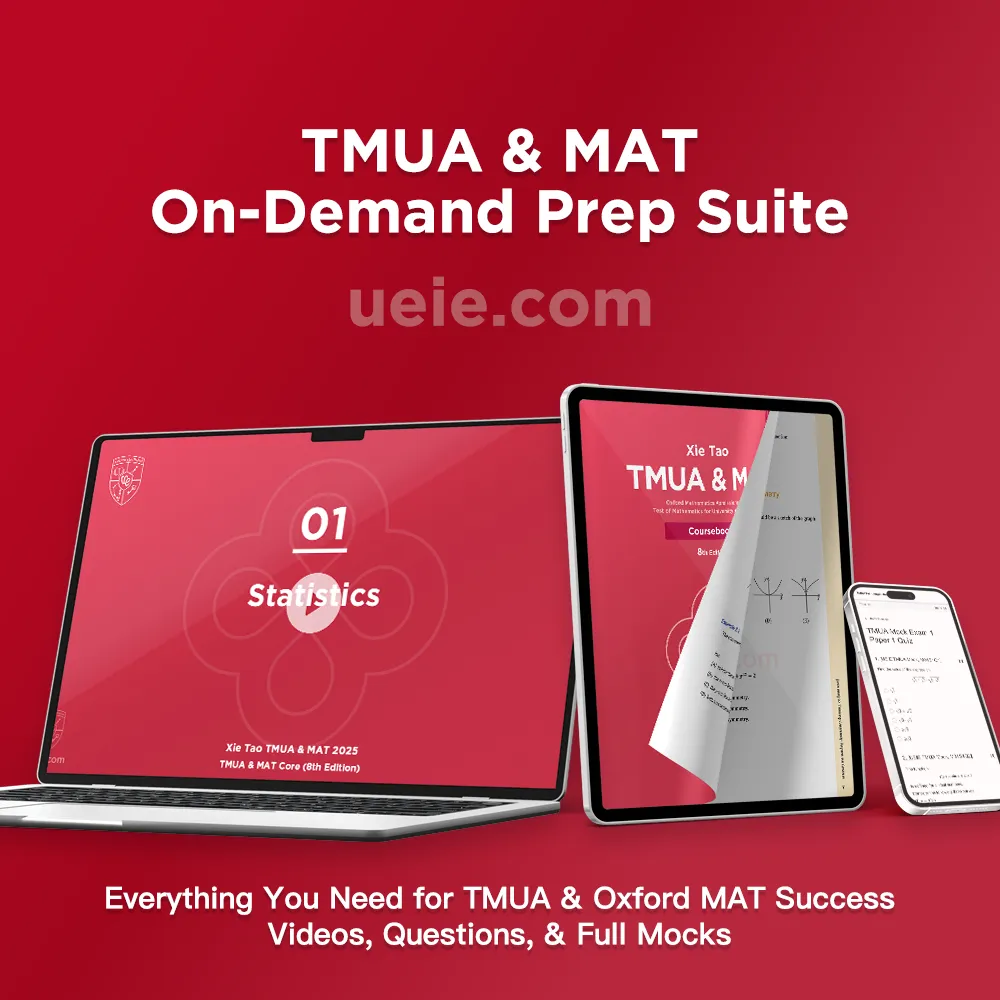
TMUA & MAT On-Demand Prep Suite
The TMUA & MAT On-Demand Prep Suite is your all-in-one solution for exam success. This comprehensive package combines Xie Tao’s expert video lectures, a massive bank of 1360 practice questions with detailed solutions, and 12 full-length mock exams that mirror the real test. Prepare thoroughly, build confidence, and achieve your target score.US$1 275 – US$1 843Price range: US$1 275 through US$1 843
Additionally, I collaborate with several international schools to offer TMUA preparation classes. Interested students and parents can find details about related courses and materials via the following link.
TMUA & MAT Live Classes
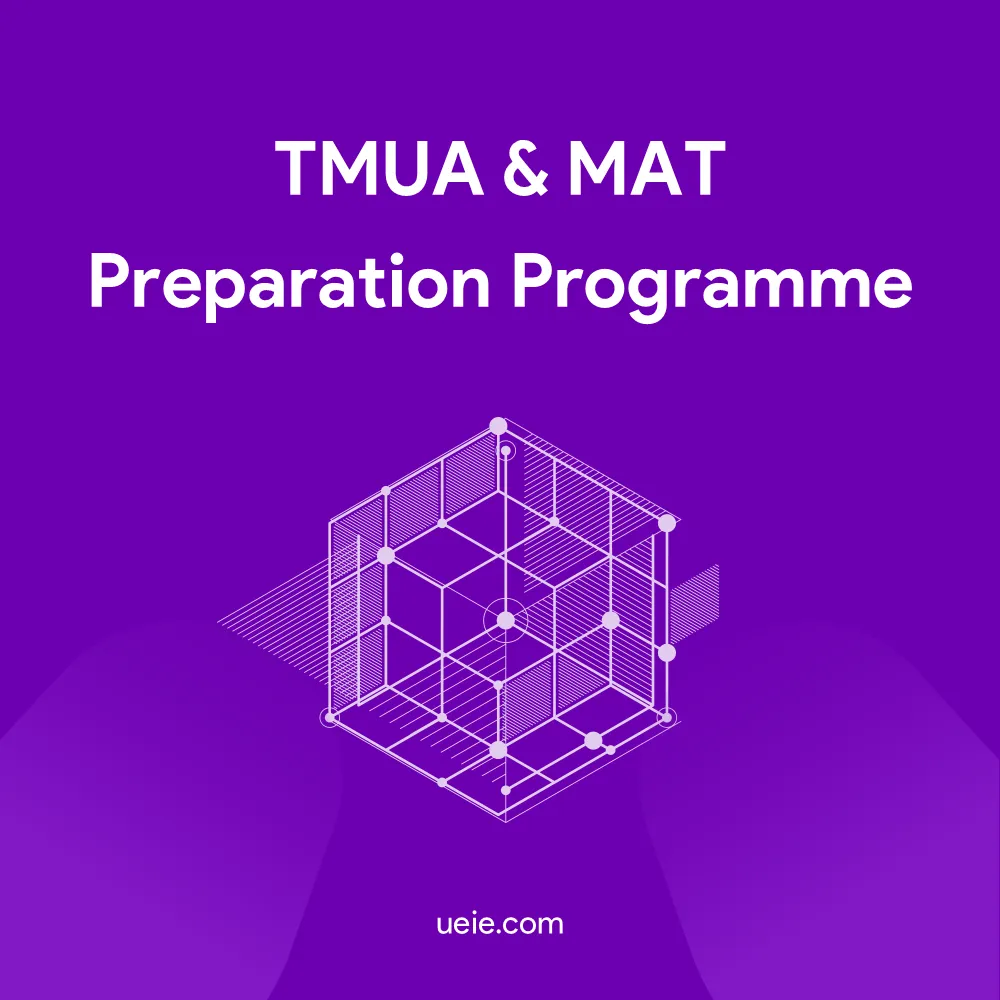
TMUA & MAT Preparation Programme
Prep for both and save time. This all-in-one programme provides 130 periods, 9 unseen TMUA mocks, 3 predictive papers, and 6 MAT mocks, helping you systematically master both exams. Click to view the bundle.US$3 096 – US$12 750Price range: US$3 096 through US$12 750
4. Other Supplementary Resources
- Relevant Mathematics Resource Websites: Websites like MEI (Mathematics Education Innovation) offer practice questions and resources related to AS/GCSE Mathematics.
- Problem-Solving Books: Some books focus on enhancing mathematical thinking, problem-solving speed, and accuracy.
- Online Communities and Forums: Platforms like The Student Room (TSR) may offer shared experiences, but please evaluate information critically.
5. Resource Usage Suggestions
- Prioritise Official Materials: Use the UAT-UK official syllabus and specimen/past papers as the core.
- Be Targeted: Select supplementary resources based on your preparation stage and weak areas.
- Select Efficiently: Quality over quantity; avoid information overload.
- Engage Actively: Actively think, deeply review, and summarise when using any resource.
X. Next Steps Recommended
After reading this Comprehensive Guide to TMUA, you should have a clear grasp of the key information regarding this test. To translate this understanding into effective application preparation, we recommend you take the following actions immediately:
1. Verify Official Requirements
Immediately visit the official admissions websites of your target universities and courses. Carefully confirm their latest and most accurate entry requirements for 2026 entry, especially regarding specific regulations for TMUA (or other admissions tests), score references, and alternative options.
2. Plan Exam Registration
Read the TMUA Registration Guide in detail to fully understand the registration process, required materials, deadlines, and test centre selection. Remember the registration deadlines and ensure you complete registration and booking within the specified timeframe.
3. Develop a Preparation Plan
Study the TMUA Preparation Guide thoroughly. Combining the difficulty analysis from Section VII and the preparation strategy from Section IX of this article, create a detailed and feasible preparation plan tailored to your situation. Start preparation early, especially for those needing significant improvement in speed and fluency.
4. Select Preparation Resources Carefully
Download and study the latest TMUA syllabus and official specimen/past papers from the UAT-UK website. Based on your preparation plan, selectively use high-quality supplementary resources, such as the preparation courses and materials offered on the UEIE TMUA preparation page, for systematic learning and targeted training.

TMUA Prep Hub
Master the TMUA with UEIE’s Prep Hub! We offer everything you need to succeed: in-depth video lecture series, extensive practice question bank, realistic full-length mock exams, expert guides, and insightful data analysis.Finally, thorough preparation and a positive attitude are key to tackling the TMUA challenge. Wishing you success in your preparation and application, ultimately securing an offer from your desired university!
-

How to Register for TMUA
For students aspiring to read mathematics, computer science, or economics-related degrees at leading UK universities, such as the University of Cambridge and Imperial College London, the Test of Mathematics for University Admission (TMUA) is a vital part of the application process. The TMUA result is a significant factor influencing offers of admission. However, many students and their parents are unacquainted with the particulars of TMUA registration, including the procedures, timelines, and appropriate test session. This article offers a thorough guide to the TMUA registration process, aiming to clarify common uncertainties.
I. TMUA Organisation and Administration
Since 2024, the TMUA has been centrally managed by UAT-UK (University Admissions Tests – UK), a not-for-profit organisation. UAT-UK focuses on university entrance examinations in the United Kingdom and currently oversees two computer-based testing programmes: ESAT and TMUA. Pearson VUE delivers these tests. It is the certification and licensure arm of Pearson, an internationally recognized learning company. With a vast network of over 5,500 test centres across more than 180 countries and territories, Pearson VUE provides professional assessment services to academic and admissions bodies globally.
II. Key Dates for the 2025 TMUA Test
The TMUA has two test sittings, scheduled for October 2025 and January 2026. The pertinent dates are outlined below:
1. October 2025 TMUA Test
31 July 2025 TMUA Registration Opens 29 September 2025 TMUA Registration Closes 13 & 14 October 2025 TMUA Test Dates 14 November 2025 TMUA Results Released 2. January 2026 TMUA Test
27 October 2025 TMUA Registration Opens 19 December 2025 TMUA Registration Closes 8 & 9 January 2026 TMUA Test Dates To Be Confirmed (anticipated within six weeks of the test) TMUA Results Released Important Notes Regarding Test Window Selection:
Applicants to the University of Cambridge must register for and sit the October examination. The January examination is not available to Cambridge applicants.
Specific Date Restriction for Certain Localities:
The University of Cambridge does not permit candidates from mainland China, Hong Kong, and Macau to sit the TMUA examination on 13 October 2025. Therefore, applicants from these localities targeting Cambridge must sit the TMUA examination on 14 October 2025.
III. TMUA Registration Procedure
1. Create a UAT-UK Account
- Candidates must create a UAT-UK account on the official Pearson VUE website. (It is prudent to consult the official UAT-UK website for the latest registration guidance).
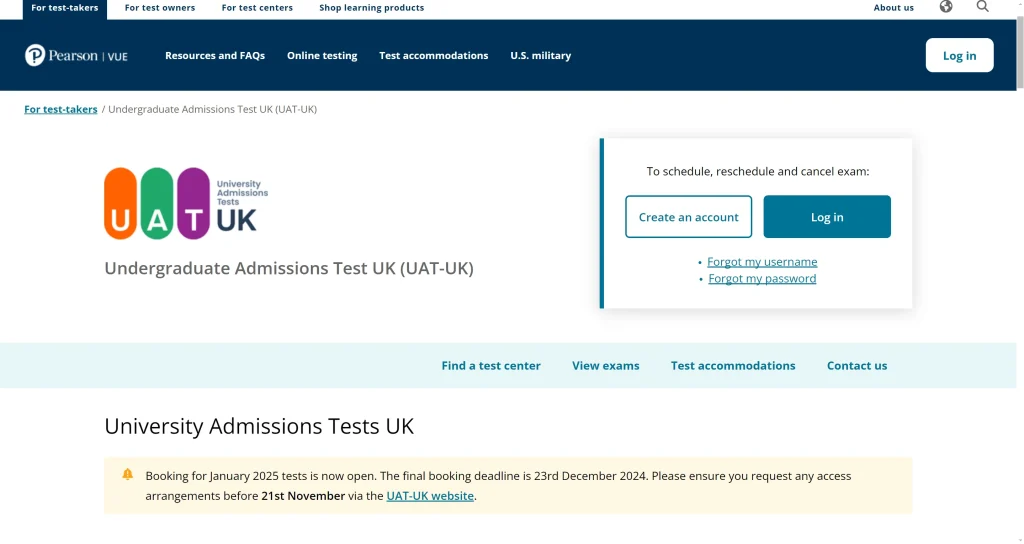
- It is imperative that the name used for UAT-UK account registration precisely matches the name on the candidate’s identification document. Discrepancies may prevent the candidate from sitting the examination. Candidates should also ensure their name matches their UCAS application name.
After creating an account, Pearson VUE will email candidates. This email enables them to confirm details and account settings. Candidates should receive it within 24 hours. This email will also include a temporary password for the candidate’s account.
- Upon receipt of the account confirmation email, candidates may log in using the temporary password, subsequently change their password, and locate their UAT-UK ID (format: UATUK######) in the top left-hand corner of the page navigation bar.
2. Examination Booking
- Log in to your UAT-UK account on the official Pearson VUE website and select the option to book the TMUA examination.

- Provide personal information pertinent to the examination. The system denotes compulsory fields with an asterisk (*).
- Candidates can locate their nearest test centre via the Pearson VUE website to complete their TMUA registration. Please note that sought-after test centres have limited places, especially as the registration deadline approaches. We strongly advise booking well in advance.
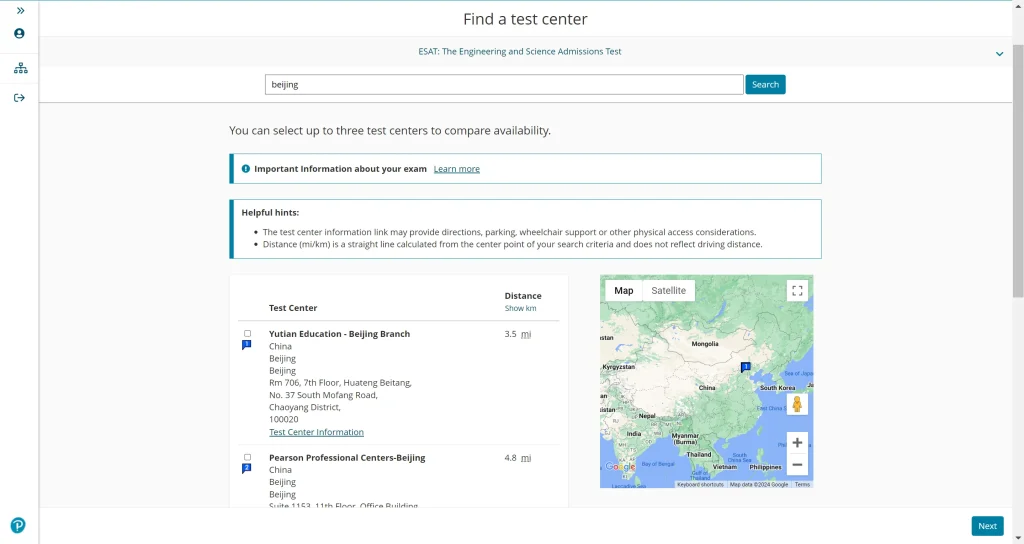
3. Post-Registration and Pre-Examination Steps
- Retain Confirmation Letter: It is strongly recommended that candidates save or print the examination confirmation letter issued by Pearson VUE once registration and payment are complete. This document usually serves as proof of entry for the examination.
- Familiarise Yourself with Test Centre Regulations: Candidates are advised to visit the Pearson VUE website or contact their test centre before the examination to apprise themselves of specific test centre rules and regulations.
- Official Contact Details: For any queries, candidates may contact the Pearson VUE candidate services helpline on 866 892 4788 (toll-free) or liaise with official customer service through the customer service centre on the Pearson VUE website.
4. Examination Fees
- For candidates sitting the TMUA examination outside the UK and the Republic of Ireland (including mainland China), the fee is generally £130.
- For candidates sitting the examination within the UK and the Republic of Ireland, the fee is £75.
IV. Access Arrangements
Candidates requiring access arrangements are advised to register for the examination at the earliest opportunity. Registering later may diminish the likelihood of securing arrangements at the preferred date and test centre. UAT-UK may take up to ten working days to process applications for access arrangements. Furthermore, the deadline for applying for access arrangements is typically in advance of the standard registration deadline. It is essential to check and submit such applications with ample time.
All applications for access arrangements must be substantiated by evidence from a medical practitioner or specialist teacher, clearly detailing the candidate’s disability, medical condition, or other relevant circumstances.
Types of access arrangements that necessitate application and approval include:
- 25% extra time
- Supervised rest breaks
- Separate invigilation (rooming)
- Use of a coloured reading overlay or bookmark
- A reader or scribe
- Other (please supply specific details of any aids or modifications required)
V. Cancelling TMUA Registration
- Candidates may cancel or amend their examination booking up to 48 hours prior to the scheduled test without penalty.
- Cancellations or amendments must be effected by logging into the Pearson VUE website account or by contacting customer services for assistance.
- Should a candidate fail to cancel or amend their booking in good time, or fail to attend the examination, the examination fee will be forfeit.
- It is important to appreciate that the TMUA examination is conducted over only two days. The feasibility of successfully rescheduling an examination date is dependent upon availability at the selected test centre.
- The precise cancellation and amendment policy will be as per the terms and conditions stipulated by Pearson VUE at the point of booking.
VI. Concluding Thoughts
In the competitive arena of applications for mathematics, computer science, and economics-related courses at Cambridge and other UK universities, a thorough grasp not only of TMUA test content and preparatory techniques but also of the nuances of the registration procedure is essential for a trouble-free application process.
You may also find it beneficial to peruse our related articles, which offer a comprehensive analysis of the TMUA examination and a study guide designed to augment your preparation and effectively enhance your TMUA score. Please click the link below.

TMUA Decoded: Mastering the Speed-Focused Maths Admissions Test
Applying for Maths, CS, or Econ at Cambridge, Imperial, LSE? Understand the TMUA test (Test of Mathematics for University Admission), managed by UAT-UK. This guide covers the online format, syllabus, 9-point scoring, key dates, and speed/accuracy focus.
Conquer the TMUA: Speed & Accuracy Training for Top Maths Scores
Aiming for a high score in the speed-focused TMUA test? This guide provides core strategies for effective preparation, focusing on enhancing calculation speed & accuracy (no calculator), developing logical agility, mastering MCQ techniques, and resource planning. - Candidates must create a UAT-UK account on the official Pearson VUE website. (It is prudent to consult the official UAT-UK website for the latest registration guidance).
-
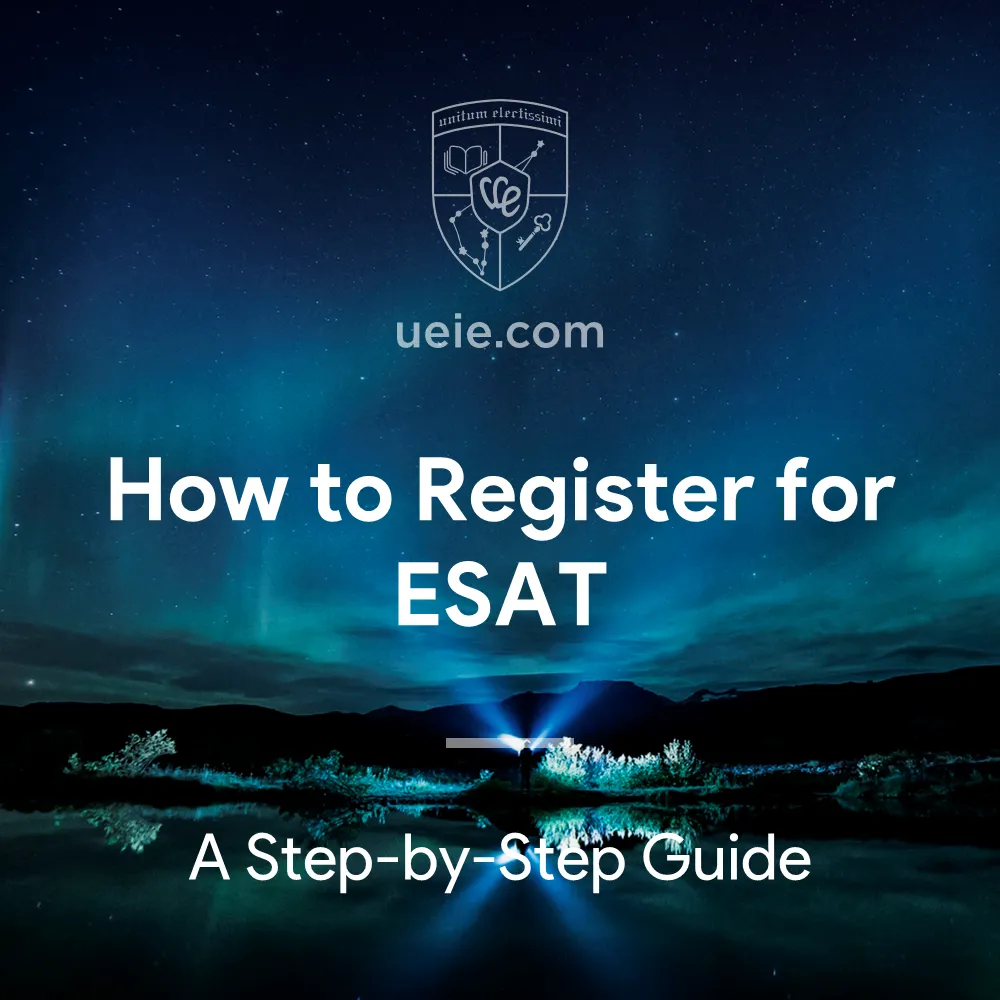
How to Register for ESAT
For students aspiring to read engineering or natural sciences at the University of Cambridge or Imperial College London, the Engineering and Science Admissions Test (ESAT) result is a key determinant of their ultimate success in gaining admission. However, many students and their parents are unacquainted with the particulars of ESAT registration, such as the procedures for enrolment, the pertinent timelines, and the appropriate examination session for which to register. This article will, therefore, provide a detailed exposition and guidance on the various processes and facets of ESAT registration, aiming to elucidate these matters and resolve any uncertainties.
I. ESAT Organisation and Administration
Since 2024, the ESAT has been centrally managed by UAT-UK (University Admissions Tests – UK), a not-for-profit organisation. UAT-UK focuses on university entrance examinations in the United Kingdom and currently oversees two computer-based testing programmes: ESAT and TMUA. Pearson VUE delivers these tests. It is the certification and licensure arm of Pearson, an internationally recognized learning company. With a vast network of over 5,500 test centres across more than 180 countries and territories, Pearson VUE provides professional assessment services to academic and admissions bodies globally.
II. Key Dates for the 2025 ESAT Examinations
The ESAT has two examination sittings, scheduled for October 2025 and January 2026. The pertinent dates are outlined below:
1. October 2025 ESAT Examination
31 July 2025 ESAT Registration Opens 29 September 2025 ESAT Registration Closes 9 & 10 October 2025 ESAT Test Dates 14 November 2025 ESAT Results Released 2. January 2026 ESAT Examination
27 October 2025 ESAT Registration Opens 19 December 2025 ESAT Registration Closes 6 & 7 January 2026 ESAT Test Dates To Be Confirmed (anticipated within six weeks of the test) ESAT Results Released Important Notes Regarding Test Window Selection:
Applicants to the University of Cambridge must register for and sit the October examination. The January examination is not available to Cambridge applicants.
Specific Date Restriction for Certain Localities:
The University of Cambridge does not permit candidates from mainland China, Hong Kong, and Macau to sit the ESAT examination on 9 October 2025. Therefore, applicants from these localities targeting Cambridge must sit the ESAT examination on 10 October 2025.
III. ESAT Registration Procedure
1. Create a UAT-UK Account
1. Candidates must create a UAT-UK account on the official Pearson VUE website. (It is prudent to consult the official UAT-UK website for the latest registration guidance).

2. It is imperative that the name used for UAT-UK account registration precisely matches the name on the candidate’s identification document. Discrepancies may prevent the candidate from sitting the examination. Candidates should also ensure their name matches their UCAS application name.
3. After creating an account, Pearson VUE will email candidates. This email enables them to confirm details and account settings. Candidates should receive it within 24 hours. This email will also include a temporary password for the candidate’s account.
4. Upon receipt of the account confirmation email, candidates may log in using the temporary password, subsequently change their password, and locate their UAT-UK ID (format: UATUK######) in the top left-hand corner of the page navigation bar.
2. Examination Booking
1. Log in to your UAT-UK account on the official Pearson VUE website and select the option to book the ESAT examination.

2. The ESAT examination comprises five sections. Typically, all candidates are required to sit the Mathematics 1 module. In addition to this, candidates will generally need to select two further modules from Mathematics 2, Physics, Chemistry, and Biology, in accordance with the requirements of their chosen university and specific programme of study. It is imperative that candidates meticulously consult the official admissions webpage of their prospective institution to confirm the precise subject combination stipulated for their intended course. Selecting an appropriate combination of subjects is likely to strengthen your university application.
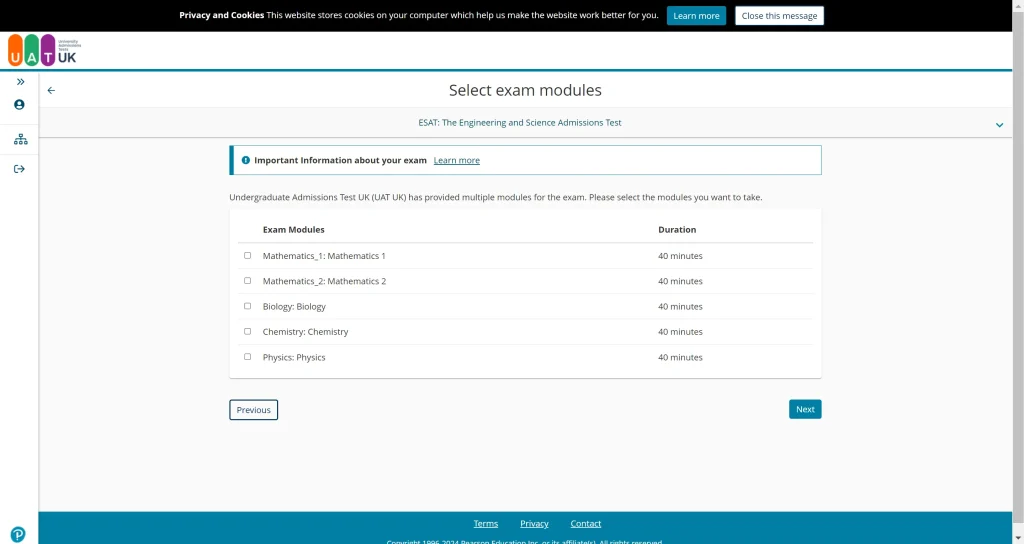
3. Provide personal information pertinent to the examination. The system denotes compulsory fields with an asterisk (*).
4. Candidates can locate their nearest test centre via the Pearson VUE website to complete their ESAT registration. Please note that sought-after test centres have limited places, especially as the registration deadline approaches. We strongly advise booking well in advance.

3. Post-Registration and Pre-Examination Steps
- Retain Confirmation Letter: It is strongly recommended that candidates save or print the examination confirmation letter issued by Pearson VUE once registration and payment are complete. This document usually serves as proof of entry for the examination.
- Familiarise Yourself with Test Centre Regulations: Candidates are advised to visit the Pearson VUE website or contact their test centre before the examination to apprise themselves of specific test centre rules and regulations.
- Official Contact Details: For any queries, candidates may contact the Pearson VUE candidate services helpline on 866 892 4788 (toll-free) or liaise with official customer service through the customer service centre on the Pearson VUE website.
4. Examination Fees
- For candidates sitting the ESAT examination outside the UK and the Republic of Ireland (including mainland China), the fee is generally £130.
- For candidates sitting the examination within the UK and the Republic of Ireland, the fee is £75.
IV. Access Arrangements
Candidates requiring access arrangements are advised to register for the examination at the earliest opportunity. Registering later may diminish the likelihood of securing arrangements at the preferred date and test centre. UAT-UK may take up to ten working days to process applications for access arrangements. Furthermore, the deadline for applying for access arrangements is typically in advance of the standard registration deadline. It is essential to check and submit such applications with ample time.
All applications for access arrangements must be substantiated by evidence from a medical practitioner or specialist teacher, clearly detailing the candidate’s disability, medical condition, or other relevant circumstances.
Types of access arrangements that necessitate application and approval include:
- 25% extra time
- Supervised rest breaks
- Separate invigilation (rooming)
- Use of a coloured reading overlay or bookmark
- A reader or scribe
- Other (please supply specific details of any aids or modifications required)
V. Cancelling ESAT Registration
- Candidates may cancel or amend their examination booking up to 48 hours prior to the scheduled test without penalty.
- Cancellations or amendments must be effected by logging into the Pearson VUE website account or by contacting customer services for assistance.
- Should a candidate fail to cancel or amend their booking in good time, or fail to attend the examination, the examination fee will be forfeit.
- It is important to appreciate that the ESAT examination is conducted over only two days. The feasibility of successfully rescheduling an examination date is dependent upon availability at the selected test centre.
- The precise cancellation and amendment policy will be as per the terms and conditions stipulated by Pearson VUE at the point of booking.
VI. Concluding Thoughts
As the 2025 ESAT examinations draw nearer, it remains of paramount importance for all students intending to apply for engineering and natural sciences programmes at the University of Cambridge and Imperial College London to acquaint themselves promptly with the latest examination updates and to familiarise themselves thoroughly with the complete ESAT registration procedure. Kindly make full use of this guide to prepare effectively for successful matriculation at your chosen institution.
Should you wish to explore further aspects of the ESAT examination, such as a comprehensive overview of test information, guidance on structuring your preparation timeline, and effective study strategies, you may also consult our other articles by clicking the link provided below.
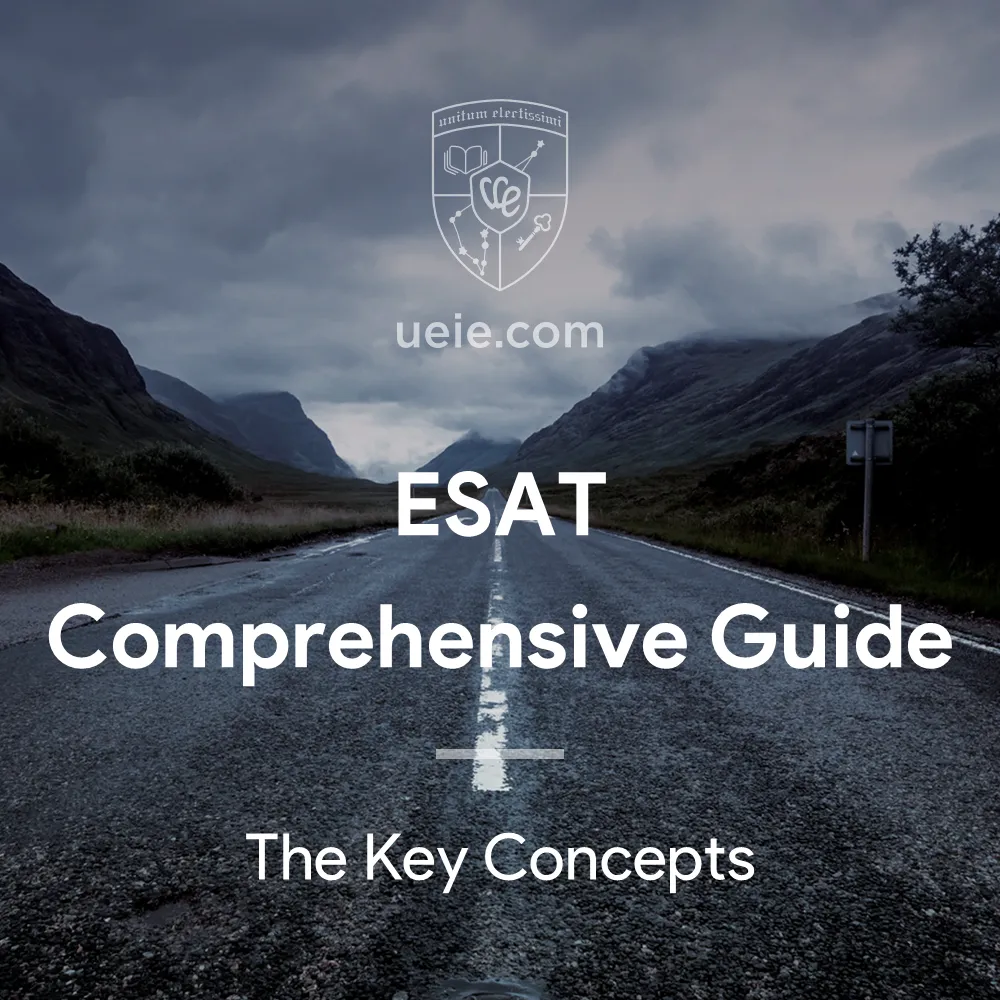
ESAT Explained: Navigating the Modular Test for Science & Engineering
Applying for Science or Engineering at Cambridge, Imperial, UCL? Learn about the ESAT test (Engineering and Science Admissions Test). This guide explains the modular structure (choose 3 of 5), online format, syllabus basics, scoring, and crucial no-calculator rule.
Conquer the ESAT: Multi-Subject Strategies for Online Test Success
Conquer the ESAT test required for top Science & Engineering courses. This guide offers strategies for multi-subject preparation (Maths, Physics, Chem, Bio), mastering the online format, enhancing speed & accuracy without a calculator, and effective resource use.